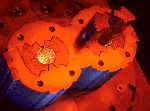 |
INTRODUCTION
CERN is the European
Organization for Nuclear Research. Founded in 1954, it is the largest particle
physics center in the world. Located on the border of France and Switzerland,
CERN provides research opportunities to scientists of at least twenty different
Member States. At CERN, researchers are given the opportunity to use
state-of-the-art accelerators, which are the main equipment for research focused
on high-energy particle reactions. CERNís ongoing commitment for the past 48
years is to explore what matter is made of, as well as what interactions between
constituents of matter.
As particle physics heads towards the 21st century, its focus is
evolving from seeking the basic constituents of matter to discovering why these
constituents act and react they way they do. The Large Hadron Collider (LHC),
being built at CERN, is the machine that will take particle physicists into this
exciting new phase of discovery.[1]
The LHC will collide high-energy proton beams at an energy of 14 TeV, allowing
the production of particles with masses up to be 1 TeV/c2.
High-energy LHC beams need strong magnets to bend the beam around the
desired path. To bend 7 TeV protons around a 15km diameter ring, the LHC dipoles
must be able to produce fields of 8.36 Tesla; over five times those used a few
years ago at the SPS proton-antiproton collider, and almost 100,000 times the
earth's magnetic field.
Superconductive materials make this possible. Superconductivity is the
property of certain materials, usually at very low temperatures, to conduct
electric current without resistance and power losses, therefore producing high
magnetic fields. For comparable power consumption, the LHC can delivery 25 times
the energy and 10,000 times the luminosity of the SPS collider.[2]
The figure shown below is a model of one of the many superconducting
dipole magnets that will be utilized in the LHC project.

Figure 1: This picture represents the model of a superconducting dipole magnet for the LHC project.
(Courtesy of CERN;
http://public.web.cern.ch/Public/TECHNOLOGY/techpict3.html)
The rising dilemma of use of
superconducting magnets revolves around the strength of the magnet. The new LHC
magnets are many times more powerful than any used previously, hence new methods
and new technology must be developed. One such method that was used in the SPS
collider requiring modification is that of mapping the magnetic field. Since no
two magnets can be manufactured identical at an atomic level, small
imperfections are introduced into every magnet. While the average magnetic field
may remain constant, some magnets produce stronger magnetic fields than others,
and the magnetic field may deviate depending on such imperfections in the magnet
itself.
A clear mapping of the magnetic
field is crucial for data collection. With knowledge of the fluctuations of the
magnetic field and where they occur, allowances for errors in the data from the
LHC can be accounted for. The mapping of the magnetic field also allows for a
quick reference to determine if certain magnets need to be replaced.
[1] From CERN Webpage: http://public.web.cern.ch/Public/about/future/whatisLHC/whatisLHC.html
[2] From CERN Webpage: http://public.web.cern.ch/Public/about/how/experiments/experiments.html